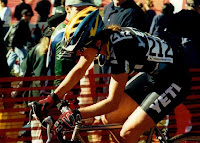 THERE ARE PLENTY OF FACTORS motivating athletes to be fit, from the glitz and glamour of victory to the cold, hard cash. But what keeps them on track is surprisingly simple – and it can work for you, too.
THERE ARE PLENTY OF FACTORS motivating athletes to be fit, from the glitz and glamour of victory to the cold, hard cash. But what keeps them on track is surprisingly simple – and it can work for you, too.
Dazzling athletic feats—from a quadruple toe loop in ice skating to a world-record marathon—inspire awe on two levels: first, by what top-echelon athletes can do with their bodies, and second by how they stay motivated to stick with a glitch-free diet and training regimen for years on end. Champion athletes indeed have the time, money and support they need to achieve their goals, but beneath it all, they are regular people who often face the same motivational ebbs and flows that we all do. “Top athletes may seem like a distinct species from the rest of us, but they also represent what’s possible in each of us,” says
TIP: Invest in yourself first each day
We are a product of our daily habits. The choices we make each day determine how we look, feel and live. Unfortunately, as work, family and social engagements fill our schedules, our diet and exercise can be pushed to the periphery. That’s why it’s important to tend to your body and mind first thing each day, no matter how small the investment. “My health comes first every morning,” says
EXERCISE: Over the next 30 days, put your health at, or near, the top of your daily to-do list. On the worksheet below, write down five things you can do first thing each morning to boost your body, whether it’s taking a 45-minute run, doing deep breathing exercises or drinking a glass of warm herbal tea. Develop the habit of “treating yourself first” each day and you’ll look better, feel better and live better.
TIP: Get your zzz’s
My mom’s advice is the guiding maxim of every successful athlete: to be your best, you need your sleep. Research shows that when you aren’t well-rested, you cannot perform at your peak in daily life—and you’ll feel too weary to work out. World-record pole-vaulter, Stacy Dragila never compromises on sleep, no matter how busy she is. “Even if I’m traveling to a race halfway around the world, I’ll get in my 8 hours,” she says. “It’s a key to my competitive success.”
EXERCISE: Use the worksheet below to map out a better sleep schedule for yourself. Also, jot a few ideas on how you can increase the quality of your sleep environment (Do you need a more comfortable mattress? More soothing lighting?). Finally, take refreshing daily pauses as often as possible. Half-hour naps are sublime on weekends. During the work-week, aim for 10-minute breaks in which you go outside, close your eyes, breathe deeply and clear your mind. These midday pauses provide powerful rejuvenation by taking your foot off the accelerator, so to speak.
TIP: Think long-term
When we watch an athlete achieve an amazing feat, we tend to think it occurred out of the blue. But, those achievements represent thousands of hours of work.
EXERCISE: View eating well and exercising as a lifelong pursuit. You needn’t accomplish all of your goals right here, right now. Accept the highs and the lows as part of the total journey and keep moving forward. Strive to improve your diet and fitness day-to-day but track your progress month-to-month; that takes the pressure off. Write down your monthly goals on the worksheet below.
TIP: Get (a little) competitive
Every champion athlete is fueled by a fierce competitive fire. While you needn’t “conquer” others in a sports arena to get motivated, you can benefit greatly from healthy competition. “Spurring yourself to greater heights by being moderately competitive can be a powerful way to keep your motivation up,” says
EXERCISE: and author of Using the worksheet, write down a few ideas on how you can push yourself to greater heights. If you prefer to test yourself, then enter an organized athletic event or challenge yourself to create healthier, more delicious meals. If you thrive on competing with others, then challenge someone to a friendly weight-loss competition.
TIP: Follow your heart
It’s motivating to know that you’re getting the most bang for your workout buck. One of the ways top athletes maximize the benefits of physical activity is by monitoring their heart rates. “Regardless of your fitness level or goals, to reap the greatest results, you must exercise at the right intensity,” says Sally Edwards, author of several heart rate books including the best-selling The Heart Rate Monitor Book. “The best way to measure exercise intensity is to monitor your heart rate continuously by using a heart monitor. In fact, this little device may be the most important investment you’ll ever make in your fitness.”
EXERCISE: Use the worksheet on page TK to calculate your ideal exercise zones and then log onto www.polarusa.com and learn more about how to use a heart rate monitor to achieve your goals.
[WORKSHEET]
HED: SUPERSTAR SUCCESS SECRET WORKSHEET
Make a copy of this worksheet, fill it out and post it in a highly-visible place that will keep your fitness and diet commitments front-and-center over the next few months.
Pay Yourself First
What five things can you do first thing in the morning to boost your health and nutrition?
Get Plenty of Rest
Map out a sleep schedule (and stick to it) over the next 30 days.
Think Long-Term
Write down your diet and fitness goals for the next six months.
Get Competitive
Write down three ideas to put some healthy competition into your diet and exercise lives
Get More from Your Workouts
In order to train “in the zone,” and get the most benefit from your workouts, you need to know your maximum heart rate, which can be approximated by subtracting your age from 220. Write that number here:
Maximum Heart Rate _________
You will use this number as the basis for your workouts. If you are striving to burn fat, boost your health and get “fit without fatigue,” then you should exercise at 60 to 80 percent of your maximum heart rate (MHR). So if your MHR is, say, 180 beats per minute, your heart rate during a fat-burning workout should be between 108 and 144 beats per minute (180 x 0.6 = 108 and 180 x 0.8 = 144.)
Fat-burning/Health-Promoting Zone:
When your fitness begins to plateau (see September issue), it may be time to insert some intervals of 30-seconds to two minutes—at 80 to 90 percent of your MHR—into your workouts.
Fitness Boosting (“Plateau Busting”) Zone:





No comments:
Post a Comment